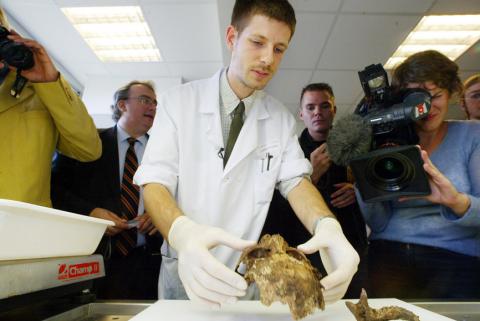The French media like to call him the “Indiana Jones of the graveyards,” but perhaps a better tag would be the Sherlock Holmes of forensic science.
With powerful microscopes and high-tech diagnostics that tease out chemical signatures and DNA telltales, pathologist Philippe Charlier pores over centuries-old remains to probe the riddles of history.
He has determined that Vatican-authenticated bone fragments said to have come from Joan of Arc were in fact from a cat and an Egyptian mummy.

Photo: AFP
He has confirmed that a mummified heart came from the uncrowned boy French king Louis XVII. He has crushed the folklore that said Napoleon was poisoned to death by his perfidious English captors.
Then in Diane de Poitiers, the mistress of King Henri II of France, Charlier made the shocking discovery that the 66-year-old had drunk an elixir of gold in what was apparently a desperate bid to keep her youth.
Now the scientist has turned his attentions to Richard the Lionheart, hoping to use what is left of his famous ticker to learn more about the legendary 12th-century English monarch.
Speaking at an exhibition on his work, Charlier referred to his ancient subjects as “patients,” for which a forensic scientist gradually develops a doctor-like relationship.
“One does tend to get attached,” he said.
Charlier used 3D imaging of a preserved skull to bring to life the face of French King Charles VII’s lover Agnes Sorel, the first woman in French history to hold the title of official mistress.
She died at the age of 28 in 1450, but her death mask belied the pixie-like beauty for which she was famed in life.
“Looking at it realistically, it’s ugly,” Charlier said of the mask, with its bulging forehead, small cheekbones and scrunched-up nose.
The scientist’s analysis determined that Sorel had died of mercury poisoning, an important ingredient of medical salts of the era.
Charlier’s laboratory is at the Raymond Poincare University Hospital in Garches, south of Paris.
In 2010, it confirmed that a severed head long thought to belong to Henry IV, murdered in 1610 by a Catholic fanatic, was indeed his — a finding that is disputed by some. Henry’s remains had been taken, along with those of other French nobles, from their tombs in the royal chapel at Saint-Denis in 1793 by revolutionaries, who tossed the remains into a pit.
The scientist is now examining a small sample of the heart of Richard I, who ruled England from 1189 to his death in 1199, apparently from blood poisoning after he was shot with an arrow.
Housed in the Gothic cathedral of Rouen, northern France, the relic comprises just a sprinkling of decomposed dust.
Charlier has taken “1mg or 2mg” of the precious remains and is carrying out chemical tests on them. The results are likely to be unveiled in the next three months, according to the French press.
The goal is to find out more about 12th-century embalming — the practice was carried out by barbers or even cooks — and perhaps identify the germ that killed the warrior-king.
“We know virtually nothing about the [embalming] techniques of that time,” Charlier told the Parisien daily. “It is a forensic challenge. We want to get the maximum information from the smallest possible sample.”
Richard is often described in textbooks as a pious leader, brave soldier and a dashing man of letters, but historians say this version masks a life of brutality, bloodshed and religious intolerance.
He led the Third Crusade of the Christian world against Muslims who had captured Jerusalem in the 12th century. He died at the age of 42 after being shot with a crossbow during a siege of the castle of Chalus-Chabrol in France.

The Burmese junta has said that detained former leader Aung San Suu Kyi is “in good health,” a day after her son said he has received little information about the 80-year-old’s condition and fears she could die without him knowing. In an interview in Tokyo earlier this week, Kim Aris said he had not heard from his mother in years and believes she is being held incommunicado in the capital, Naypyidaw. Aung San Suu Kyi, a Nobel Peace Prize laureate, was detained after a 2021 military coup that ousted her elected civilian government and sparked a civil war. She is serving a

China yesterday held a low-key memorial ceremony for the 1937 Nanjing Massacre, with Chinese President Xi Jinping (習近平) not attending, despite a diplomatic crisis between Beijing and Tokyo over Taiwan. Beijing has raged at Tokyo since Japanese Prime Minister Sanae Takaichi last month said that a hypothetical Chinese attack on Taiwan could trigger a military response from Japan. China and Japan have long sparred over their painful history. China consistently reminds its people of the 1937 Nanjing Massacre, in which it says Japanese troops killed 300,000 people in what was then its capital. A post-World War II Allied tribunal put the death toll

‘NO AMNESTY’: Tens of thousands of people joined the rally against a bill that would slash the former president’s prison term; President Lula has said he would veto the bill Tens of thousands of Brazilians on Sunday demonstrated against a bill that advanced in Congress this week that would reduce the time former president Jair Bolsonaro spends behind bars following his sentence of more than 27 years for attempting a coup. Protests took place in the capital, Brasilia, and in other major cities across the nation, including Sao Paulo, Florianopolis, Salvador and Recife. On Copacabana’s boardwalk in Rio de Janeiro, crowds composed of left-wing voters chanted “No amnesty” and “Out with Hugo Motta,” a reference to the speaker of the lower house, which approved the bill on Wednesday last week. It is

FALLEN: The nine soldiers who were killed while carrying out combat and engineering tasks in Russia were given the title of Hero of the Democratic People’s Republic of Korea North Korean leader Kim Jong-un attended a welcoming ceremony for an army engineering unit that had returned home after carrying out duties in Russia, North Korean state media KCNA reported on Saturday. In a speech carried by KCNA, Kim praised officers and soldiers of the 528th Regiment of Engineers of the Korean People’s Army (KPA) for “heroic” conduct and “mass heroism” in fulfilling orders issued by the ruling Workers’ Party of Korea during a 120-day overseas deployment. Video footage released by North Korea showed uniformed soldiers disembarking from an aircraft, Kim hugging a soldier seated in a wheelchair, and soldiers and officials